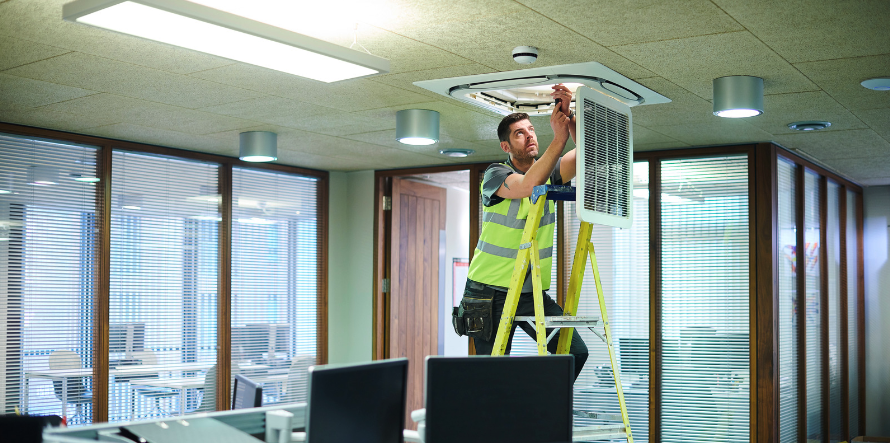Commercial property maintenance involves a slew of responsibilities, often shared across several team members at any given time. Depending on your industry, commercial property maintenance responsibilities vary greatly and could include everything from updating a building’s HVAC system, fixing light fixtures, moving office furniture, or monitoring for mold.
To remain organized and efficient, many commercial property maintenance teams rely on computerized maintenance management systems, or CMMS.
Although it originated as on-site hardware, cloud-based CMMS is now more widely used and preferred. Continue reading to learn more about cloud-based CMMS and its benefits to commercial property maintenance.
The Evolution of CMMS
Two to three decades ago, most companies had on-premise CMMS hardware that ran off of on-site computers. Although on-premise CMMS meant more reliable, faster, secure solutions, it came with many limitations:
- Could not scale as a company grew
- Lacked accessibility
- Difficult to integrate with other systems
- Required manual security updates
- Often required complex coding
In the early 2000s, an alternative to on-premise CMMS was introduced: cloud-based CMMS. The new solution solved many of the problems that CMMS hardware presented and has been widely adopted ever since.
What Is the Difference Between Work Order Software and CMMS?
Comparing work order software and CMMS is like comparing a steering wheel to a car. While work orders and work order software are an important part of commercial property maintenance, they only make up a fraction of CMMS capabilities.
Work order software can report on the number of work orders completed in a given time period, provide reporting of work done on a specific piece of equipment, and centralize all work order data.
Meanwhile, CMMS goes beyond work order management and gives managers the means to:
- Efficiently schedule technicians
- Control inventory
- Run preventive maintenance protocols
- Track assets
- Purchase items
- Manage budgets
- Monitor team performance
Today, most organizations use cloud-based CMMS to run commercial property maintenance.
7 Benefits of Cloud-Based CMMS
Paired with today’s fast-paced and technological environment, cloud-based CMMS has become a critical asset to commercial property maintenance teams. Below are top benefits of cloud-based CMMS.
1. Faster and less expensive setup.
After registering for cloud-based CMMS and undergoing onboarding, your organization can then start using the software for CRE maintenance in an extremely short amount of time. Many of today’s software packages are designed to be very user friendly with easy-to-use graphic interfaces and quick deployment for team members. On-site CMMS historically required waiting for the hardware to arrive, and configuring and installing the hardware.
2. Enables teams to make decisions quicker.
With cloud-based CMMS, teams can place and process maintenance requests nearly instantaneously, from any location. One team member could submit a request from the field, an administrator could then assign the request to the appropriate technician, and the technician could check the request from their mobile device and immediately get to work.
3. Guaranteed accessibility and availability.
Because there is no central hardware hub for cloud-based CMMS, it can be accessed from home, work, or on the road, at any time. Cloud-based CMMS is also “always on” with the exception of routine software updates—perfect for organizations with 24-hour production schedules.
4. Improved team collaboration.
Cloud-based CMMS organizes CRE maintenance data in one central place, making it easy for maintenance teams to share information across the entire organization. Transparent data sharing also often leads to better, more cohesive teamwork.
5. Easy integration and data sharing among other tech.
To share data between a cloud-based CMMS and existing software, organizations simply use an application programming interface (API). This form of automatic data sharing reduces the risk of duplicate data entries, and ensures that information isn’t lost or siloed elsewhere. When adopting a cloud-based CMMS, it’s best to look for one that can be seamlessly integrated with your existing tech stack.
6. Real-time monitoring.
Cloud-based CMMS can also be connected (still via an API) to internet-connected equipment sensors. These sensors can then send real-time performance data to your CMMS and automatically generate maintenance requests, as needed. Real-time monitoring of equipment also greatly impacts the creation of predictive and preventive maintenance schedules.
7. Frequent system updates.
With cloud-based CMMS, software updates are often included in your subscription fee and completed much more frequently than previous on-site CMMS. Routine updates can even be scheduled during a slow time, like weekends, to minimize disruptions.
Between its quick setup and accessibility, cloud-based CMMS offers insurmountable benefits to commercial property maintenance teams. Has your organization adopted cloud-based CMMS yet?
Want more commercial real estate resources?
Our blog features frequent content, straight from our commercial real estate experts. Subscribe to receive weekly content right in your inbox, on topics like advice and opinions on the state of the industry, market reports, and updates about the Allegro team.







